ISSN: 2320-2459
ISSN: 2320-2459
Wim Vegt*
Department of Physics, Eindhoven University of Technology, Eindhoven, The Netherlands
Received: 23-Jan-2024, Manuscript No. JPAP-24- 128117; Editor assigned: 26- Jan-2024, PreQC No. JPAP-24- 128117 (PQ); Reviewed: 09-Feb- 2024, QC No. JPAP-24-128117; Revised: 16-Feb-2024, Manuscript No. JPAP-24-128117 (R); Published: 23-Feb-2024, DOI: 10.4172/2320- 2459.12.1.004
Citation: Vegt W. Unification Theory for Classical Mechanics, Electrodynamics, Quantum Physics, General Relativity and the Interaction between Gravity and Light. Res Rev J Pure Appl Phys. 2024;12:004.
Copyright: © 2024 Vegt W. This is an open-access article distributed under the terms of the Creative Commons Attribution License which permits unrestricted use distribution and reproduction in any medium, provided the original author and source are credited.
Visit for more related articles at Research & Reviews: Journal of Pure and Applied Physics
In this new theory the interaction between gravity and light has been discussed at astronomical levels; Gravitational RedShift, Black Holes and Dark Matter and at sub-atomic levels; the absorption and emission of light at sub-atomic levels in concentric spheres by an atom at discrete energy levels.
Differently than in general relativity, the interaction between gravity and light fundamentally has been based on the sum of the “Stress Energy Tensor” and the introduced “Gravitational Tensor”.
The theory describes “Gravitational-Electromagnetic Interaction” resulting in a mathematical tensor presentation for Black Holes. (Gravitational Electromagnetic Confinements) the “Electromagnetic Energy Gradient” creates a second order effect “Lorentz Transformation” which results in the gravitational field of black holes which determines the interaction force density between the confinement of light (black hole’s) and the gravitational field.
Einstein approached the interaction between gravity and light by the
introduction of the “Einstein Gravitational Constant” in the 4-dimensional
Energy-Stress Tensor 
In this alternative approach related to general relativity, the interaction
between gravity and light has been presented by the sum of the
Electromagnetic Tensor  and the Gravitational Tensor
and the Gravitational Tensor
The new theory describes the impact of "CURL" within the gravitational fields around black holes and the impact on gravitational lensing. Gravitational "CURL" (Equation 6) is an effect which cannot be explained and calculated by general relativity.
The new approach presents mathematical solutions for the black holes (gravitational electromagnetic interaction) introduced in 1955 by John Archibald Wheeler in the publication in Physical Review Letters in 1955. The mathematical solutions for black holes are fundamental solutions for the relativistic quantum mechanical Dirac equation (Quantum Physics) in tensor presentation (41). Assuming a constant speed of light “c” and Planck’s constant ħ within the black hole, the radius “R” of the black hole with the energy of a proton, is about 1% of the radius of the hydrogen atom (14).
The new theory has been tested in an experiment with 2 galileo satellites and a ground station by measuring the gravitational redshift in an by the ground station emitted stable MASER frequency. The difference between the calculation for gravitational redshift, within the gravitational field of the Earth, in “General Relativity” and the “New Theory” is smaller than 10-16 (12) and (13).
In all “General Redshift Experiments” general relativity and the new theory predict a gravitational redshift with a difference smaller than 15 digits beyond the decimal point which is beyond the accuracy of modern “Gravitational Redshift” observations. Both values are always within the measured gravitational redshift in all observations being published since the first observation of the gravitational redshift in the spectral lines from the white dwarf which was the measurement of the shift of the star Sirius B, the white dwarf companion to the star Sirius, by W.S. Adams in 1925 at Mt. Wilson Observatory.
Theories which unify quantum physics and general relativity, like “String Theory”, predict the non-constancy of
natural constants. Accurate observations of the NASA messenger observe in time a value for the gravitational constant “G” which constrains until  One of the characteristics of the new theory
is the “Constant Value” in time for the Gravitational constant “G” in unifying general relativity and quantum physics.
One of the characteristics of the new theory
is the “Constant Value” in time for the Gravitational constant “G” in unifying general relativity and quantum physics.
Quantum physics; General relativity; Gravitational redshift; Black holes; Dark matter
An alternative approach in gravity
Einstein approached the interaction between gravity and light by the introduction of the “Einstein Gravitational Constant” in the 4-dimensional Energy-Stress Tensor

In which equals the Einstein tensor
equals the Einstein tensor equals the Metric tensor
equals the Metric tensor equals the Stress-Energy tensor,
equals the Stress-Energy tensor, equals the cosmological constant and
equals the cosmological constant and equals the Einstein gravitational constant.
equals the Einstein gravitational constant.
An alternative approach to Einstein’s expression with the tensor  describing the curvature of the space-time continuum, is the sum of the Electromagnetic tensor
describing the curvature of the space-time continuum, is the sum of the Electromagnetic tensor and the Gravitational tensor
and the Gravitational tensor

The 4-dimensional divergence of the sum of the electromagnetic stress-energy tensor and the gravitational tensor expresses the 4-dimensional force-density vector (expressed in [N/m3] in the 3 spatial coordinates) as the result of electro-magnetic-gravitational interaction [1-3].

In vector notation the 4-dimensional force-density vector can be written as:
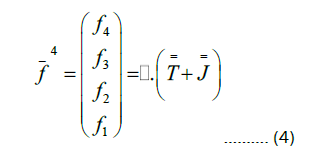
The fundamental boundary condition for this alternative approach to gravity is the requirement that the force 4 vector equals zero in the 4 dimensions, expressing a universal 4-dimensional equilibrium:
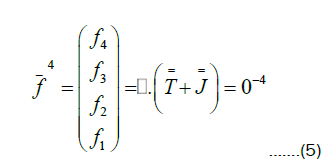
The 3 spatial components of the force-density vector, as a result of electro-magnetic-gravitational interaction can be written as:

In which:
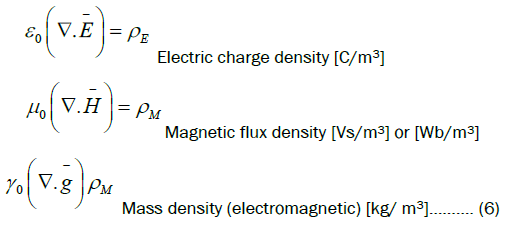
Electric energy density:

Magnetic energy density: 
Gravitational energy density: 
In which E represents the electric field intensity expressed in [V/m], H represents the magnetic field intensity
expressed in [A/m] and g represents the gravitational acceleration expressed in [m/s2]. The permittivity indicated as
For curl-free gravitational fields equation (6) can be written as:

Substituting Einstein’s W=m c2 in (7) results in “Electro-Magnetic-Gravitational Equilibrium Field Equation” (8):

The theory describes “Electromagnetic-Gravitational Interaction”, “Magnetic-Gravitational Interaction” and “Electric- Gravitational Interaction”. In this new theory particles do not interact with fields. The interaction between an electric charged particle and an electric field is not the interaction between a particle and a field but it is the interaction between the electric field of the particle interacting with the other electric field. Every interaction is an interaction between fields. Electric fields interact with electric fields, magnetic fields interact with magnetic fields and gravitational fields interact with gravitational fields.
Gravitational redshift/ blueshift in “light (EMR)” due to “electromagnetic gravitational interaction”
To test the new theory, the gravitational-redshift experiment; “Test of the Gravitational Redshift with Galileo Satellites in an Eccentric Orbit” by Hermann et al. has been chosen. In this experiment a stable “MASER” frequency from a ground station has been emitted to 2 galileo satellites, measuring the frequency difference between the ground station and the satellites. The frequency shift has been caused by the gravitational field of the Earth and 2 satellites has been chosen to compensate for the eccentricity of the Galileo Orbit.
Assuming a gravitational field g[z] depending on the radial direction in cartesian coordinates between the ground station and the satellites:

In which G (G=6.67428 10-11 Nm2/kg2) equals the Gravitational constant, MEarth the mass of the earth and r the radial distance from the centre of the earth. The mathematical solution of equation (8) for plane electromagnetic waves (expressed in cartesian {x,y,z} coordinates) related to the electric field intensity equals:

And the mathematical solution of (8) for the magnetic field intensity equals:

In which ω0 equals the original frequency of the MASER radiation propagating in the direction of the gravitational field g[z] of the Earth in the z-direction. The exponential term demonstrates the gravitational redshift when the MASER radiation propagates in the direction of the gravitational field of the Earth. The propagation speed of the electromagnetic radiation remains constant (the speed of light). But the amplitude of the field intensity and the frequency of the field intensity diminishes exponentially.
Calculations in mathematica demonstrate a difference between the calculation with general relativity and the calculation with the new theory. Choosing for the ground station a distance to the centre of the Earth z1= 6,378,000 m (radius of the Earth) and for the average distance of the ESA satellites in a Galileo orbit Z2= 23,222,000 m (distance from the ESA satellite to the centre of the Earth), calculated with mathematica, the gravitational redshift according general relativity equals [4-15].

Calculated with mathematica, the gravitational redshift according the new theory, which is a solution of equation (8) equals:

Both calculated values a within the range of the measured gravitational redshift by the average values of both ESA satellites in the Galileo orbit

In a factor α has been defined which presents the measured deviation α between the predicted gravitational redshift by general relativity and the measured gravitational redshift.

A comparable factor α can be used to determine which theory (general relativity or the new theory) has the nearest approach to the experimentally measured data. Highly accurate measuring experiments are required with an accuracy higher than 16 digits beyond the decimal point.
Black holes
Black holes without singularities with dimensions smaller than the diameter of the hydrogen atom: A second fundamental solution for equation (8) describes a gravitational electromagnetic confinement (black hole) within a radial gravitational field with acceleration  (in radial direction). This solution represents a black hole, the
confinement of light due to its own gravitational field, and has no singularities. This solution for equation (8)
describes black holes, dependent of time and radius, presenting discrete spherical energy levels, within a radial
(in radial direction). This solution represents a black hole, the
confinement of light due to its own gravitational field, and has no singularities. This solution for equation (8)
describes black holes, dependent of time and radius, presenting discrete spherical energy levels, within a radial
gravitational field with acceleration  (in radial direction) has been represented in equations (16) and (17).
(in radial direction) has been represented in equations (16) and (17).


In which the radial function f(r) equals:

G represents the gravitational constant and M represents the total confined electromagnetic mass of the black hole. Equation (16) presents a standing (confined) electromagnetic field configuration with a phase shift of 90 degrees between the electric field and the magnetic field with the corresponding nodes and antinodes [13]. The solution has been calculated according Newton’s shell theorem.
Assuming a constant speed of light “c” and Planck’s constant ħ within the black hole, the radius “R” (with n= 1,2,3,4….) of the black hole with the energy of a proton, according W=mproton c2, would be: 1.5009211 × 10−10 J.

Black holes are varying from atomic dimensions with dimensions of 10-27 kg, until black holes with dimensions of 1040 kg, At these dimensions black holes turn into dark matter. The fundamental boundary condition for the confinement of electromagnetic radiation (black holes) is that the energy flow (Poynting vector)  equals zero at the surface of the confinement. This is possible at every “90 degrees phase shift surface” (Sphere) between the electric field and the magnetic field.
equals zero at the surface of the confinement. This is possible at every “90 degrees phase shift surface” (Sphere) between the electric field and the magnetic field.
Black holes with a singular point and large dimensions
In Figure 1 represents a black hole with a mass of 1035 kg and a radius of about 25 km controlled by a different mathematical solution for equation (8). The radius of the black hole equals about 25 km which has been controlled by a different mathematical solution (19) for equation (8).

In Figures 1 and Figure 2 demonstrate the large effect of “Gravitational Intensity Shift” and “Gravitational RedShift” at the distance of 25 km. Over a distance of 10,000 km the intensity of the emitted light of the black hole with a mass of 1035 kg falls back with a factor of 10-51. Also the frequency of the emitted light of the black hole falls back with a factor 10-51. Emitted light in the visible spectrum of 1014 Hz falls back to a frequency of 10-37 Hz. These extreme low frequencies with extreme low intensities have never been measured which has result in the name “black hole” for the phenomenon of “Gravitational Intensity Shift” and “Gravitational RedShift” for a large mass. It follows from equation (8) and the solutions (10) and (11) that the speed of light does not change inside and around black hole. Only the direction of the propagation of light can change due to a gravitational field [16-29].
Dark matter in the universe controlled by “gravitational shielding”
In Figure 3 represents dark matter with a total mass of 1053 kg and a radius of about 10 times the size of the Milky way galaxy. The radius of the dark mass equals 5 × 1021 m which has been controlled by a different mathematical solution (20) for equation (8).

Figures 3 and 4 demonstrate the large effect of “Gravitational Intensity Shift” and “Gravitational RedShift” at the distance of 5 × 1021 m which is 10 times the radius of the Milky way galaxy. Over the distance of 5 × 1021 m, the intensity of the emitted light of the dark matter with a mass of 1053 kg falls back with a factor of 10-261. Also the frequency of the emitted light of the black hole falls back with a factor 10-261. Emitted light in the visible spectrum of 1014 Hz falls back to a frequency of 10-247 Hz. These extreme low frequencies with extreme low intensities have never been measured which has result in the name “Dark Matter” for the phenomenon of “Gravitational Intensity Shift” and “Gravitational RedShift” for an extreme large mass. It follows from equation (8) and the solutions (10) and (11) that the speed of light does not change inside and around the dark mass. Only the direction of the propagation of light can change due to the gravitational field of the dark mass.
The relationship between black holes and quantum physics
Introducing the quantum vector function 
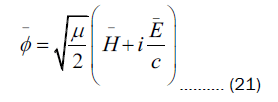
Substituting (21) in (16) results in the quantum presentation for the black hole:

With "K" a constant value dependend of the mass of the black hole. The dot product between the unit vector and
the quantum vector function  represents the quantum mechanical probability function
represents the quantum mechanical probability function  which is a fundamental solution of the Schrödinger wave equation.
which is a fundamental solution of the Schrödinger wave equation.

The Scalar function  represents a fundamental solution of the quantum mechanical Schrödinger wave equation [36, 37] .
represents a fundamental solution of the quantum mechanical Schrödinger wave equation [36, 37] .
Black holes with discrete spherical energy levels at sub-atomic dimensions
An essential requirement for the confinement of electromagnetic energy is that the poymtingvector equals zero at the (spherical) surface of the confinement. For the confinement within a sphere, a standing electromagnetic wave pattern has been required which exists of concentric spheres, at every sphere an antinodal plane for E (or B) with a radius distance between each sphere of half the wavelength of the confinement. The constant �� = �� �� �� ,“n” a natural number (1,2,3,4…..) and �� the wavelength.
Time and radius dependent black holes with discrete energy levels, the confinements of electromagnetic radiation within spherical regions
In Figures 5 and 6, Every concentric sphere represents an anti-nodal surface for the Electric field (E) or the
Magnetic Ffield (H). The pointing vector^:  at this spherical surface equals zero at any time and at
any location at this sphere. The electromagnetic energy remains always within this sphere and the next concentric
sphere. The concentric spheres have a difference in radius of one half wavelength of the electromagnetic radiation
within the confinement and a different discrete energy level. Every concentric sphere represents an anti-nodal
surface of the electric field or the magnetic field [30-35].
at this spherical surface equals zero at any time and at
any location at this sphere. The electromagnetic energy remains always within this sphere and the next concentric
sphere. The concentric spheres have a difference in radius of one half wavelength of the electromagnetic radiation
within the confinement and a different discrete energy level. Every concentric sphere represents an anti-nodal
surface of the electric field or the magnetic field [30-35].
Equation (24) describes a time and radius dependent black hole.
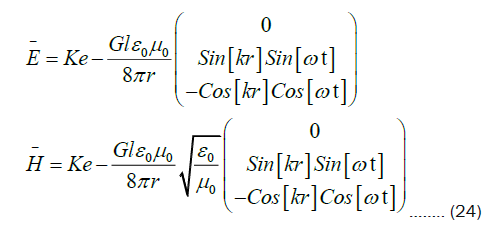
Equation (20) represents by the function  the confinement of electromagnetic radiation
between two concentric spheres. K represents the amplitude of the electric/magnetic field intensity [14].
the confinement of electromagnetic radiation
between two concentric spheres. K represents the amplitude of the electric/magnetic field intensity [14].
Time and polar angle dependent black holes
Equation (25) describes a time and “polar angle” dependent black hole shown in Figures 7 and 8
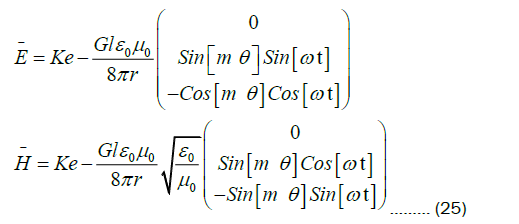
Equation (19) represents by the function Sin[m θ] (m=1,2,3,4….) the confinement of electromagnetic radiation between two polar angular regions [15].
Time and azimuthal angular dependent black holes
Equation (26) describes a time and “Polar Angle” dependent black hole shown in Figure 9.
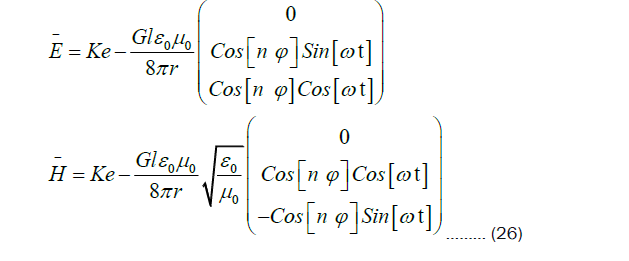
Equation (26) represents by the function  the confinement of electromagnetic radiation
between two azimuthal angular regions [16].
the confinement of electromagnetic radiation
between two azimuthal angular regions [16].
Time, polar- and azimuthal angular dependent black holes
Equation (27) describes a time “azimuthal angle” and “polar angle” dependent black hole shown in Figure 10.
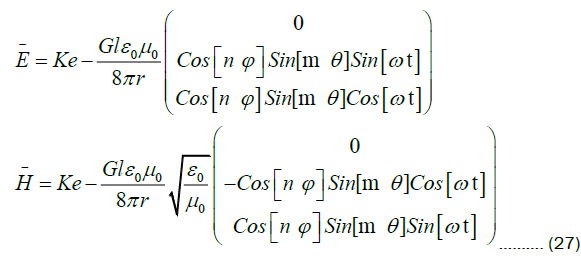
Equation (27) represents by the function  the confinement of electromagnetic radiation between two azimuthal angular regions and two polar angulars regions [17].
the confinement of electromagnetic radiation between two azimuthal angular regions and two polar angulars regions [17].
Spherical confinement of light between two concentric spheres within black holes
Equation (18) represents the reflection of the confined electromagnetic energy within the black hole between two concentric spheres while the speed of light, depending on the variable “r”, changes in direction with the frequency of the confined light (electromagnetic radiation).
In Figures 11 and 12 a black hole can split into two new black holes with different radi. The original black hole falls back into a lower energy level while the new black hole represents the difference in energy levels comparable with an atom falling back into a lower energy level.
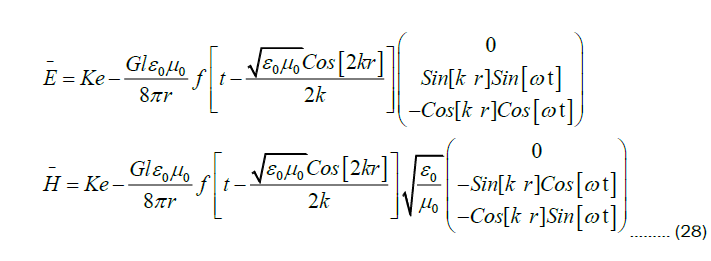
Universal equilibrium in the “concept of quantum mechanical probability” in “the new theory”.
The 4-dimensional notation for the divergence of the stress-energy tensor (25) expresses in the 4th dimension (time dimension) the law of conservation of energy”. For an electromagnetic field the law for conservation of energy has been expressed as:
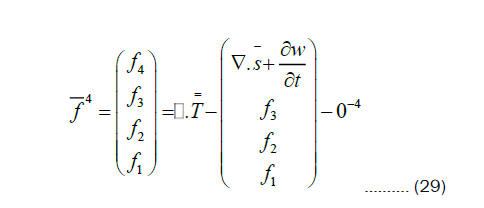
From the equation for the “Conservation of Electromagnetic Energy” (38.1) the “Fundamental Equation for Confined Electromagnetic Interaction” in “The New Theory” will be derived, which equals the relativistic quantum mechanical “Dirac” equation and the Schrödinger wave equation at velocities relative low compared to the speed of light.
The “Fundamental Equation for Confined Electromagnetic Interaction” in “The Proposed Theory” can be considered to be the relativistic version of the quantum mechanical Schrödinger wave equation, which equals the quantum mechanical Dirac equation [36-38].
Confined electromagnetic energy within a 4-dimensional equilibrium
The physical concept of quantum mechanical probability waves has been created during the famous 1927 5th solvay conference. During that period there were several circumstances which came just together and made it possible to create a unique idea of “Material Waves” (solutions of Schödinger’s wave equation) being complex (partly real and partly imaginary) and describing the probability of the appearance of a physical object (elementary particle) generally indicated as “Quantum Mechanical Probability Waves”.
The idea of complex (probability) waves is directly related to the concept of confined (standing) waves. Characteristic for any standing acoustical wave is the fact that the velocity and the pressure (electric field and magnetic field in QLT) are always shifted over 90 degrees. The same principle does exist for the standing (confined) electromagnetic waves,
For that reason every confined (standing) electromagnetic wave can be described by a complex sum vector  of the electric field vector
of the electric field vector and the magnetic field vector
and the magnetic field vector 
The vector functions  and the complex conjugated vector function
and the complex conjugated vector function  will be written as:
will be written as:

 equals the magnetic induction,
equals the magnetic induction,  the electric field intensity (
the electric field intensity (  has+90 degrees phase shift compared to B ) and c the speed of light.
has+90 degrees phase shift compared to B ) and c the speed of light.
The complex conjugated vector function  equals:
equals:

The dot product equals the electromagnetic energy density w:

Using Einstein’s equation W = m c2, the dot product equals the electromagnetic mass density w:

The cross product is proportional to the Poynting vector [3].

This article presents a new “Gravitational-Electromagnetic Equation” describing electromagnetic field configurations which are simultaneously the mathematical solutions for the scalar quantum mechanical “Schrodinger Wave Equation” and more exactly the mathematical solutions for the tensor representation of the “Relativistic Quantum Mechanical Dirac Equation” (41).
The 4-dimensional divergence of the sum of the electromagnetic stress-energy tensor expresses the 4-dimensional force-density vector (expressed in [N/m3] in the 3 spatial coordinates) as the result of electro-magnetic-gravitational interaction.

In vector notation the 4-dimensional force-density vector can be written as:
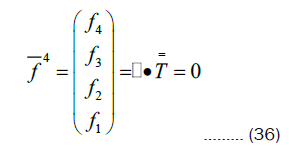
The fundamental boundary condition for this alternative approach to gravity is the requirement that the force 4 vector equals zero in the 4 dimensions, expressing a universal 4-dimensional equilibrium.
The 3 spatial components of the force-density vector, as a result of electro-magnetic-gravitational interaction can be written as;
Substituting the electromagnetic values for the electric field intensity “E” and the magnetic field intensity “H” in (36) results in the 4-dimensional representation of the electro-magnetic-gravitational fields equation (37)
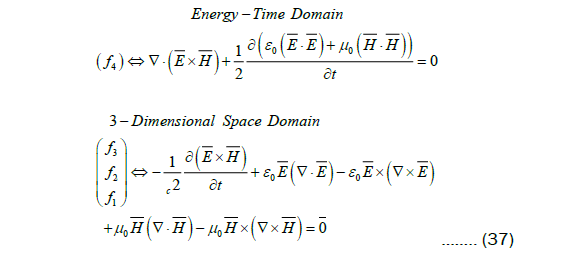
In which f1, f2, f3, represent the force densities in the 3 spatial dimensions and f4 represent the force density (energy flow) in the time dimension (4th dimension). Equation (37) can be written as:
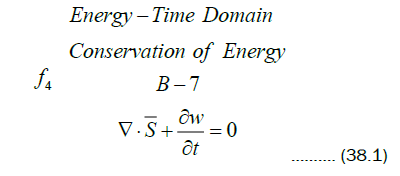
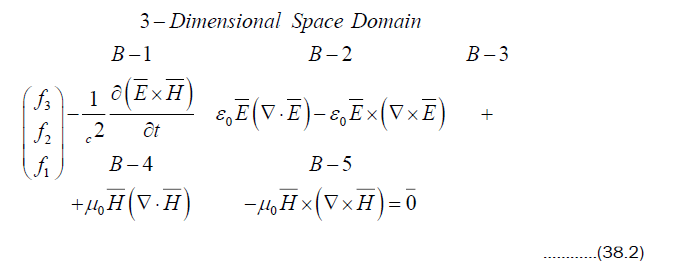
The 4th term in equation (38.1) can be written in the terms of the Poynting vector “S” and the energy density “w” representing the electromagnetic law for the conservation of energy (Newton’s second law of motion).
The 4-dimensional relativistic dirac equation
Substituting (32) and (34) in Equation (38.1) results in the 4-dimensional tensor presentation for the relativistic quantum mechanical Dirac equation (39)

To transform the electromagnetic vector wave function  into a scalar (spinor or one-dimensional matrix representation), the Pauli spin matrices σ and the following matrices [3] are introduced:
into a scalar (spinor or one-dimensional matrix representation), the Pauli spin matrices σ and the following matrices [3] are introduced:

The equations (6), (32) and (34) can be written in tensor presentation as the 4-dimensional relativistic quantum mechanical Dirac equation [3] :


Based on the assumption of the zero rest mass of photons, General Relativity describes the interaction between gravity and light within a 4-dimensional curvature in space and time due to a gravitational field. Light follows a path defined by this curved 4-dimensional space and time geometry.
The new theory, describes a bi-directional separation between mass and inertia for light (photons). Inertia can only exist only in the direction of propagation of the beam of light (photons) which determines the speed of light. Mass of the beam of light (photons) can only exist in the plane perpendicular to the direction of propagation (directions of confinement), which determines the deflection of a beam of light (photons) by a gravitational field in the plane perpendicular to the direction of propagation.
Black holes (gravitational-electromagnetic confinements) are fundamental solutions of the relativistic quantum mechanical Dirac equation. Black holes represent the large impact of “Gravitational Intensity Shift” and “Gravitational RedShift” due to a gravitational field. Both phenomena can maybe observed in the future with extremely sensitive observatories at extreme low frequency levels.
The new theory describes the impact of "CURL" within the gravitational fields around black holes and the impact on gravitational lensing. Gravitational "CURL" (Equation 6) is an effect which cannot be explained and calculated by general relativity
Within a 4-dimensional equilibrium and taking into account the inertia- and the gravitational- force densities within the electromagnetic field configurations, Gravitational electromagnetic confinements (black holes at sub-atomic dimensions) are a physical reality and are solutions of the relativistic quantum mechanical Dirac equation (39, 41) and present spherical confinements with discrete separate energy levels.
To test the proposed theory with general relativity, an experiment has been required which measures the interaction between gravity and light within a well-defined gravitational field like the gravitational field of the earth. The difference between the calculation for gravitational redshift, within the gravitational field of the Earth, in “General Relativity” and “The New Theory” is smaller than 10-16 and cannot be determined with present observation equipment (maximum accuracy of 10-15 for GRS). Validation of both theories requires higher accuracies.
Dark matter does exist because of “Gravitational RedShift” and Gravitational Intensity Shift”. A complete galaxy, existing of billions bright light emitting star constellations, with a total mass of 1053 kg becomes invisible for any observatory like the “James Webb Space Telescope” at the distance of 5 × 1021 m (which is 10 times the radius of the Milky Way Galaxy). This distance of “Gravitational Shielding” has been controlled by the mathematical solution (20) for equation (8). The gravitatonal field of these Galaxies has not been effected by the effect of “Gravitationa RedShift” and “Gravitational IntensityShift” at all.
For this reason, a large percentage of the total mass in the Universe beyond the border of “Gravitational Shielding” becomes invisible for our observatories on and close around the earth. While the gravitational fields of these galaxies still has the full influence on our universe.
All Data and Calculations have been published at: https://quantumlight.science/
[Crossref]
[Crossref]
[Crossref]